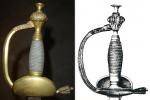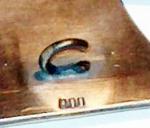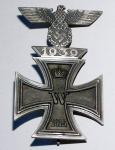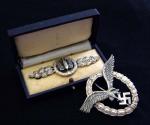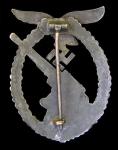-
Posts
3,397 -
Joined
-
Last visited
-
Days Won
3
Content Type
Profiles
Forums
Blogs
Gallery
Events
Store
Everything posted by J Temple-West
-
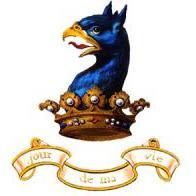
Luftwaffe Repro Flak Badge
J Temple-West replied to ERIC's topic in Germany: Third Reich: Wehrmacht Medals, Decorations & Awards
Arrr me hearty... be it Walter Henlein or W Hobacher. I never knows which it be. has ye an idea? Sorry my friend...I've just been playing Pirates with the kid. I'll be back to adult lingo tomorrow. -

Luftwaffe Repro Flak Badge
J Temple-West replied to ERIC's topic in Germany: Third Reich: Wehrmacht Medals, Decorations & Awards
It looks like they used a "W H" flak to make that one. -
Hi Eric, I?m in the same boat as Rich. It?s hard to see any details from these pix (Any others available?) so hard to comment on particulars, other than the hinge/pin issue. I will say that there are some very good fakes of this badge going around, most with the same style barrel hinge but usually with a ?C? catch. So, to get to grips with this badge, I think it?ll come down to one of those that will require a lot more investigation. I certainly wouldn?t buy it from the pix supplied, and if, for example, I saw it at a show, had the choice of this one and one that was perhaps less minty, but text book? I know which one I?d go for.
-

Luftwaffe WHY?
J Temple-West replied to Edgar Estrada's topic in Germany: Third Reich: Wehrmacht Medals, Decorations & Awards
I think I?m right in saying that when the ?RK? was first awarded to members of the Luftwaffe, the criteria was based on an accumulation of a 20 points total?. 1 point for downing a single-engine aircraft, 2 points for a twin-engine aircraft and 3 points for a four-engine aircraft. All points were doubled for kills at night. As the war progressed, the criteria (total points) was continually adjusted upwards, I assume the same is true for the criteria for Oak Leaves... swords and diamonds. -

Luftwaffe WHY?
J Temple-West replied to Edgar Estrada's topic in Germany: Third Reich: Wehrmacht Medals, Decorations & Awards
Hi Edgar... An interesting question. There could be several reasons? Pilots such as Galland and M?lders had a head start by being involved in the Spanish civil war and would have been put in the spotlight as heroes before Steinhoff started his combat career in 1939. I?m sure that answering Hitler, on being asked (During the award ceremony for Steinhoff?s Oak Leaves to the Knights Cross: 1942) what he thought of the war in the East and the new territory that would be gained once the war was won: "I hope the F?hrer will not become too attached to it, because I don't think we will be taking up long-term residence" would not have helped him win any favours with the Nazi Party. As the war progressed, and the tide turned against Germany, Steinhoff became very outspoken when it came to the treatment of his pilots and often criticized Hitler and G?ring for using them as cannon fodder, to the point where he was threatened with a court-martial after he and other high ranking commanders tried to have G?ring replaced as head of the Luftwaffe during the so called ?Luftwaffe Revolt? of 1945. So, even though He flew more than 900 missions and engaged in aerial combat in over 200 sorties, scoring 176 kills, I believe that his ?attitude? was probably considered to be not was looked for in a loyal hero of the Reich. -

Prussian Civil Service or German Court Sword?
J Temple-West replied to Hauptmann's topic in Swords & Edged Weapons
Here you go, Dan: a comparison between your sword and a Prussian civil service sword from the W K & C catalogue. Of course there will be slight differences from maker to maker, but the two are very similar in design. -

Fake One piece 1914 EK1 with Spange.
J Temple-West replied to J Temple-West's topic in Germany: All Eras: The Iron Cross
-

Fake One piece 1914 EK1 with Spange.
J Temple-West posted a topic in Germany: All Eras: The Iron Cross
-
Hi Chris, It?s always difficult to give an opinion on cloth items but I?ll try and explain why I think this is a modern reproduction. First a little background on the cufftitle. In 1933, shortly after Hitler took power, Hermann G?ring created a new police unit named, after a few organizational changes, ?Landespolizeigruppe General G?ring.? The unit?s duties were to stamp out any resistance to the new regime and were put into action seeking out Communist agitators operating in German cities. On the 22nd December 1933, a new cufftitle was introduced for wear by members of the ?Gruppe? and bore the inscription ?L.P.G. General G?ring? in Gothic script on a dark green band. In September 1935, ?Landespolizeigruppe General G?ring? was transferred to the newly formed Luftwaffe and renamed ?Regiment General G?ring? On the 23rd March 1336, the new regimental cufftitle was introduced by Luftwaffenverordnungsblatt Nr 12, order Nr 348. The title bore the inscription ?General G?ring? in Gothic script. The lettering was executed in silver-grey or matte-silver machine embroidery for enlisted men & NCO?S, with the NCO version having Russia-braid edging to the borders. Officers? versions had the lettering/Russia-braid executed in hand embroidered aluminium thread/braid. The ?General G?ring? title was replaced by the more common ?Hermann G?ring? in 1942. So, so far your title meets the descriptions in most reference works for a NCO title. However, when you look at the title and compare it with known originals, the lettering, although machine-embroidered, looks very thin and poorly executed, not what I would expect to see on an original piece, originals having a much thicker thread, giving a much more substantial look to the lettering. Also, only one font style was used on originals and as you will see in the comparison, the lettering on your?s (open tops on the ?G?s? and thin ?L?) just doesn?t come near to the quality of the original. Of course this is only one opinion, for peace of mind, other opinions should be sought. Comparison of your title (top) with an original NCO title (bottom) from my files.
-
Early ?Assmann? Flak badges were produced in heavily nickel silver plated tombak. As the war progressed and high grade materials became harder to obtain, manufacturers turned to zinc in an attempt to maintain supply for the ever increasing demand for awards, medals and badges. In the early days of the use of zinc, badges were still finished by means of plating until, again, the lack of materials forced makers to use compounds that gave the appearance of a white, or silver, finish. This badge is a good example of the early days of transition from tombak to zinc as the obverse has been finished by means of nickel silver plating and is, from the obverse, indistinguishable from its earlier tombak counterpart. The reverse (unplated) shows a typical setup (hinge/catch plates) for zinc badges produced by ?Assmann? and is the best way of detecting whether tombak or zinc has been used as a base metal.






